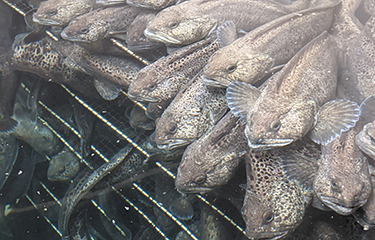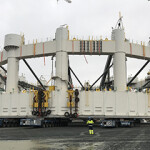Aminor, Buena Vista Seafood tout little-known species as next big thing

A new, one-of-a-kind aquaculture operation in Norway is developing farming techniques for a new species, and Buena Vista Seafood is seeing success in the U.S. with imported fillets of the fish.
The spotted wolffish, Anarchichas minor, is a species being developed under the name “Arcticas” by Halsa, Norway-based Aminor. The bottom-dwelling species historically has been caught as bycatch of other fisheries, and according to Aminor, it is uniquely suited to being raised via aquaculture.
“[We] have considered this as maybe the most-suitable new fish species in Norwegian aquaculture, when it comes to sustainability and all the main criteria,” Aminor Sales and Marketing Director Jan Brekke Jenssen told SeafoodSource.
According to Aminor, which started farming wolffish in 2013 and is the only company in the world with an active breeding and aquaculture program for the species, the fish is one of the most sustainable species in part thanks to its biology. It has a high survival rate, and it is a very social fish that does not need to be constantly moving like other species. Its social nature, and temperament, also means it’s largely docile and performs better when stocked at higher densities than lower densities – a low-density tank often ends up with the fish huddling together in one part of it.
“It’s a lazy fish, and it’s a very social fish. You should think it is aggressive. Yes it is called a wolffish, and you think they should be eating each other, but they are very social,” Jenssen said.
Currently, Aminor stocks its tanks at the legal limit of stocking density – which it found lowers mortality. Because the fish are so docile and social, the current farming method involves a series of shelves where the fish all stack on top of each other, and farmers can reach in and pick up a fish by hand.
Polly Legendre, who work on business development for Buena Vista Seafood, told SeafoodSource throughout her tours of aquaculture facilities the world over, she had never seen a species quite like the spotted wolffish in terms of farming.
“This is new, it’s absolutely new, and it is kind of crazy that we haven’t heard about it before,” Legendre said.
According to Jenssen, the current method involves a “mother” fish – which weighs something like 28 kilograms – that produces the smaller fish, which the company harvests at between 2.5 and 5 kilograms, with a fillet yield of between 54 and 57 percent. As of yet, the species has no known disease issues. That could also explain the latest mortality rates – the last hatch came out with less than 0.02 percent mortality, and Jenssen said Aminor averages 1.5 percent mortality with its wolffish farming.
The wolffish's feed ratios are also good, Jenssen said – good enough that the company is working to make sure they’re fully verified, as they appear to be better than for salmon. Currently, the feed-conversion ratio is being studied for each individual generation, and the lowest has been 0.6 to 1 – and it has never gone over 1 to 1.
The facility uses a land-based flow-through aquaculture system that produces virtually no discharge, another positive in terms of farming sustainability, Jenssen said.
Further enhancing the species’ sustainability are the new shipping boxes that Aminor is using. Instead of using polystyrene foam, the company is using an all-cardboard solution.
“We have double-sided, double-bottom cardboard boxes that are approved for air freight,” Jenssen said. “We are using dry ice instead of wet ice, and dry ice is made out of CO2, so you actually take out some of the oxygen in the box for a period of time.”
Using dry ice and the carboard boxes reduces the amount of plastic pollution created by shipping the fish, and it also is better in terms of carbon footprint – the dry ice is lighter than other chilling solutions and reduces the weight of the box allowing for more efficient transport, he said.
Perhaps best of all in terms of making spotted wolffish viable for commercial sales is quality of the product itself, Jenssen said. Farmed wolffish has a higher fat content than wild wolffish, reaching up to 11 percent. The fat content, texture, and flavor of the fish is what’s helping Legendre sell it to high-end chefs in California, she said.
“We started cooking it and we were like, 'It’s like a mashup of Chilean sea bass meets monkfish meets black cod,’” said Legendre, who has also spent time as a chef and was the first American to graduate from Ecole Superieure de Cuisine Française.
Legendre said she has tried a number of different cooking methods on the wolffish supplied by Aminor, and has had success with most of them – including a Korean fried chicken style method. The fish holds together well enough it can be cooked on a grill, or on skewers, without breaking apart.
“I’m pretty happy, I just got a text message ... from a two-Michelin-star chef, and he’s putting it on the menu,” Legendre said.
Commercializing a relatively unknown species is taking time, she said. Chefs want to get to know the product first, and that takes time and effort.
“We have to get the fish into their hands, since it’s something new that they’ve never seen before, they have to work it – touch it, feel it, try it,” she said.
Distributors, as well, need to be convinced to have another SKU in their line-ups.
Legendre said she believes wolffish can become a well-known whitefish that consumers can find for sale at retail. Because of its structure, it’s incredibly difficult to overcook, making it a great choice for home cooks unfamiliar with seafood, she said.
“It’s rich-tasting, it holds together really well, and it’s incredibly easy to cook,” she said. “It’s not like anything you’ve ever come across before.”
Photo courtesy of Polly Legendre/Buena Vista Seafoods






Share